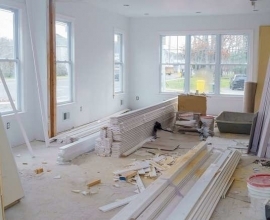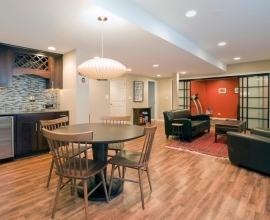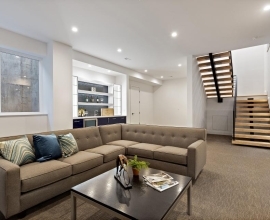Types of Foundations For Your New House
When deciding on which type of foundation (basement, crawl space, or a slab) for your new home, there are many different factors to consider. In some parts of the country full basements will be the norm (most common in the north), while others will have slab foundations (most common in the south) and still others will have crawl spaces (most common in the central regions). Many people, because of local soil and groundwater conditions, often have only one or two options when it comes to house foundations. In certain places, constructing a full basement means blasting through solid rock. In other places, the ground water table may be lurking just a few feet below the surface limiting these folks to a simple slab on grade.
Keep in mind, that if you are planning a crawl space, and all of your neighbors have basements, your house may be more difficult to sell unless you are prepared to lower the price. This is simply a value/price perception issue since many people feel that having a full basement gives them more room even if it is used only for storage purposes. And of course, the potential is always there for someone to finish the basement and add extra living space at some time in the future.
The concrete slab choice is attractive to builders because of its relatively low cost. Excavation is kept to a minimum and the construction schedule can often be accelerated. The day after the slab is poured, wall framing can often begin. But slabs come with some negatives. Typically, plumbing drainage and water supply lines are buried beneath the slab. If something goes wrong or a leak develops, repairs can be costly. Heating or cooling ductwork buried underneath the slab (not recommended) can sometimes fill with water during wet seasons. Should this happen, fungus can form and spores might be blasted into the home each time the HVAC starts up. Thermal conduction issues are always present. Slabs poured in colder climates can conduct cold back into the house unless special precautions are taken when built. Homes built on slabs often offer little protection during tornadoes or hurricanes, unless a special masonry or concrete safe room is built within the house. These safe rooms can be designed as a large walk-in closet.
A crawl space foundation is a step or two above a slab foundation. Generally speaking, a footing needs to be poured and short foundation walls are built to support the home. Crawl space foundations allow you to install plumbing and HVAC systems so that they are accessible. The floor system over and the foundation walls inside of the crawl space almost always need to be insulated. A vapor barrier must be placed over the soil in the crawl space to control moisture, preferably one that is sealed at its seams & to the foundation walls. If this vapor barrier is missing, water vapor will readily travel up into the wood floor system and then into the house. This water vapor can cause severe mold problems. Homes built over crawl spaces offer minimal protection in severe weather unless you can install a floor access door in a closet that allows quick entry into the crawl space, assuming there is sufficient clearance.
As for basements, ask any homeowner who has a dry full height foundation and they will often tell you they would never be without one. The cost per square foot for this bonus space is often a fraction of what you pay for the living space stacked above it. If you do an actual cost analysis of a full height foundation versus a crawl space, you will find it costs very little to upgrade to the full foundation. Typically, full basements make a house more attractive to potential buyers.
A full foundation offers superb protection in the event of severe weather. It is not difficult to keep basements dry, even in extreme wet weather. The builder simply needs to install a proper drainage system around the perimeter and to apply a real waterproofing material such as synthetic rubber or liquid asphalt that has rubber additives. These materials can bridge small hairline cracks that might otherwise leak water. If you intend to finish off the basement space at a later date, be sure to install a true waterproofing material not the traditional hot asphalt damp-proofing spray.
If you can afford the extra cost, ask your builder to consider extra height foundation walls that allow you to have a clear ceiling height of eight feet or more beneath any and all beams that support floor joists, so that finishing the space at a later time will be easier and provide proper ceiling height.
Eric Lachance is the heart of Royal Renovations Ottawa. Eric has more than 25 years of experience in the contracting and remodeling/renovation industry. All of his projects are completed professionally, meticulously and with great pride which is demonstrated by his superior craftsmanship.
Article Source: https://bit.ly/3AOV2zi







